Ganesh Chaturthi
| Ganesh Chaturthi | |
|---|---|
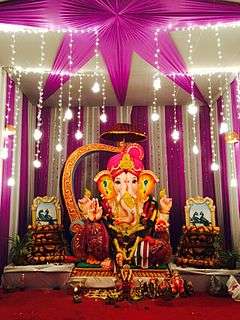 Ganesha Festival, Hyderabad | |
| Official name | Ganesha Chaturthi/Vinayaka Chaturthi |
| Also called | Chavath, Ganeshotsav |
| Observed by | Hindus |
| Type | Religious |
| Celebrations | Chanting of Vedic hymns and Hindu texts, prayers, martial arts, last day: processions, idol immersion |
| Begins | Bhadrapada Shukla |
| Ends | 11 day after start |
| Date | Bhadrapada (August–September) |
| 2017 date | Friday, 25 August |
| 2018 date | Thursday, 13 September |
| Frequency | Annual |
Ganesh Chaturthi (IAST: Gaṇēśa Chaturthī), also known as Vinayaka Chaturthi (Vināyaka Chaturthī), is the Hindu festival that reveres god Ganesha.[1] A ten-day festival, it starts on the fourth day of Hindu luni-solar calendar month Bhadrapada, which typically falls in Gregorian months of August or September. The festival is marked with installation of Ganesha clay idols privately in homes, or publicly on elaborate pandals (temporary stage). Observations include chanting of Vedic hymns and Hindu texts such as Ganapati Upanishad, prayers and vrata (fasting).[1] Offerings and prasada from the daily prayers, that is distributed from the pandal to the community, include sweets such as modaka believed to be a favorite of the elephant-headed deity.[2][3] The festival ends on the tenth day after start, wherein the idol is carried in a public procession with music and group chanting, then immersed in nearby water body such as a river or ocean, thereafter the clay idol dissolves and Ganesha is believed to return to Mount Kailasha to Parvati and Shiva.[1][4]
The festival remembers Ganesha's birthday, and celebrates him as the god of good beginnings, prosperity and obstacle remover. It is observed throughout India, especially as a public event in the western states of India such as Maharashtra, Gujarat and Chhattisgarh,[1][5] usually as a private home festival in other states such Goa, Tamil Nadu, Telangana, Andhra Pradesh and Madhya Pradesh where it overlaps with the Teej festival.[6] At public venues, along with the reading of texts and group feasting, athletic and martial arts competitions are held.[7] It is unclear when the festival started, it may have South Indian origins, but historical evidence suggests it became a major social and public event with sponsorship of Shivaji after Muslim-Hindu (Mughal-Maratha) wars, and again in the 19th century after public appeal by Indian freedom fighter Lokmanya Tilak,[8] who championed it as a means to circumvent the colonial British government ban on Hindu gatherings through its anti-public assembly legislation in 1892.[9][10][6]
Ganesha Chaturthi is also observed in Nepal and by the Hindu diaspora elsewhere such as in the Trinidad, Suriname, Fiji, Mauritius,[11] United States and Europe[4][12] (such as in Tenerife, Spain).[13][14]
Origins

The earliest mention of Ganapati, now considered equivalent to Ganesha or Vinayaka, is found in the Rigveda (about 13th century BCE). It appears twice in the Rigveda, once in hymn 2.23.1, as well as in hymn 10.112.9.[15][16][17] Both of these hymns imply a role of Ganapati as "the seer among the seers, abounding beyond measure in food presiding among the elders and being the lord of invocation", while the hymn in mandala 10 states that without Ganapati "nothing nearby or afar is performed without thee", according to Michael.[15][18] However, it is uncertain that the Vedic term Ganapati which literally means "guardian of the multitudes", referred specifically to later era Ganesha, nor do the Vedic texts mention Ganesha Chaturthi.[19][16]
Ganapati appears in post-Vedic texts such as the Grhya Sutras and thereafter ancient Sanskrit texts such as the Vajasaneyi Samhita, the Yajnavalkya Smriti and the Mahabharata mention Ganapati as Ganesvaras and Vinayakas. However, all of these mention not a singular idea of a Ganapati as is found in the Vedic texts, but the concept in the plural. Further, the plural form of the concept has the context of a "trouble maker".[20] The Buddhists texts and iconography of the 1st millennium CE show Buddhist deities trampling this "trouble maker".[21] Some scholars state that this "trouble maker" may have referred to different Ganapatis than Ganesha.[22]
Ganesha appears in the medieval Puranas, but not as "trouble maker", but in the form of "god of success, obstacle remover". The Skanda Purana, Narada Purana and the Brahma Vaivarta Purana, in particular, profusely praise him.[23] Beyond textual interpretations, archeological and epigraphical evidence suggest Ganesha had become popular, was revered before the 8th century CE and numerous images of him are traceable to 7th century or earlier. For example, carvings at Hindu, Buddhist and Jain temples such as at the Ellora Caves, dated between the 5th and 8th century show Ganesha reverentially seated with major Hindu goddesses (Shakti).[24] His worship and festivities were likely in vogue by the 10th century, as is evidenced by the texts of the Ganapatyas tradition of Hinduism, who placed him as equivalent to the metaphysical concept of Brahman, and the god of "blessings, protection, wisdom and divine illumination".[25][26]
History
Although it is unknown when (or how) Ganesha Chaturthi was first observed,[27] the festival has been publicly celebrated in Pune since the era of Shivaji (1630–1680, founder of the Maratha Empire).[27] After the start of the British Raj, the Ganesha festival lost state patronage and became a private family celebration in Maharashtra until its revival by Indian freedom fighter and social reformer Lokmanya Tilak.[27] The festival, along with processions, was already in vogue as a public and a private celebration in Mumbai (then called Bombay) in 1885, according to the eyewitness account by a visiting Italian Sanskrit professor Angelo de Gubernatis:
I followed with the greatest curiosity crowds who carried in procession an infinite number of idols of the god Ganesh. Each little quarter of the town, each family with its adherents, each little street corner I may almost say, organizes a procession of its own, and the poorest may be seen carrying on a simple plank their little idol or of papier mâché... A crowd, more or less numerous, accompanies the idol, clapping hands and raises cries of joy, while a little orchestra generally precedes the idol.
– Angelo de Gubernatis, Bombay Gazette (1886)[28][29]
According to others such as Kaur, the festival became a public event later, in 1892 when Bhausaheb Laxman Javale ( also known as Bhau Rangari), installed the first sarvajanik (public) Ganesha idol in Pune.[30] In 1893, the Indian freedom fighter Lokmanya Tilak praised the celebration of sarvajanik Ganesha utsav in his newspaper, Kesari, and dedicated his efforts to launch the annual domestic festival into a large, well-organised public event.[31] Tilak recognized Ganesha's appeal as "the god for everybody",[32] and according to Robert Brown, he chose Ganesha as the god that bridged "the gap between Brahmins and non-Brahmins", thereby building a grassroots unity across them to oppose British colonial rule.[33]
Other scholars state that the British Empire, after 1870 out of fear of seditious assemblies, had passed a series of ordinances that banned public assembly for social and political purposes of more than 20 people in British India, but exempted religious assembly for Friday mosque prayers under pressure from the Indian Muslim community. Tilak believed that this effectively blocked the public assembly of Hindus whose religion did not mandate daily prayers or weekly gatherings, and he leveraged this religious exemption to make Ganesh Chaturthi to circumvent the British colonial law on large public assembly.[8][9][6] He was the first to install large public images of Ganesha in pavilions in Bombay Presidency, and other celebratory events at the festival.[34][note 1]
Why shouldn't we convert the large religious festivals
into mass political rallies?
—Lokmanya Tilak, Kesari, 8 September 1896[39]
According to Richard Cashman, Tilak recruited and passionately committed himself to god Ganesha after the 1893 Hindu-Muslim communal violence in Bombay and the Deccan riots, when he felt that the British India government under Lord Harris had repeatedly taken sides and not treated Hindus fairly because Hindus were not well organized.[40] In Tilak's estimate, Ganesha worship and processions were already popular in rural and urban Hindu populations, across social castes and classes in Baroda, Gwalior, Pune and most of the Maratha region in the 18th century.[41] In 1893, Tilak helped expand Ganesh Chaturthi festival into a mass community event and a hidden means for political activism, intellectual discourse, poetry recitals, plays, concerts, and folk dances.[42]
In Goa, Ganesha Chaturthi predates the Kadamba era. The Goa Inquisition had banned Hindu festivals, and Hindus who did not convert to Christianity were severely restricted. However, Hindu Goans continued to practice their religion despite the restrictions. Many families worship Ganesha in the form of patri (leaves used for worshiping Ganesha or other gods), a picture drawn on paper or small silver idols. In some households Ganesha idols are hidden, a feature unique to Ganesh Chaturthi in Goa due to a ban on clay Ganesha idols and festivals by the Jesuits as part of the Inquisition.[43]
Celebrations
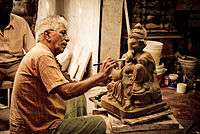
Public Preparations for the festival begins months ahead. They are usually funded by local residents, businesses and community organizations.The idol making in Maharashtra usually begins with "Padya pooja" or worshipping the feet of Lord Ganesh. The idols are brought to "pandals" or temporary structures usually 15–20 days before. The pandals have elaborate decoration and lighting.
At home the festival begins with the purchase and then the ceremonial installation of a clay murti (idol). Families decorate a small, clean corner with flowers and other colourful items before installing the idol. When the idol is installed, it and its shrine are decorated with flowers and other materials.

In preparation for the festival, artisans create clay models of Ganesha for sale. The idols range in size from 3⁄4 inch (1.9 cm) for homes to over 70 ft (21 m) for large community celebrations.[44]
The date for the festival is usually decided by the presence of Chaturthi Thithi. The festival is held during "Bhadrapada Madyahanaa Purvabaddha". If the chaturthi thiti begins at night on previous day and gets over by morning on next day then the next day is observed as vinayaka chaturthi. In the consecration ceremony, a priest performs a Prana Pratishtha to invite Ganesha like a guest. This is followed by the 16-step Shodashopachara ritual,[45] (Sanskrit: Shodash, 16; Upachara, process) during which coconut, jaggery, modaks, durva grass and red hibiscus flowers are offered to the idol. Depending on the region of India,during the ceremony, hymns from the Rigveda, the Ganapati Atharvashirsa, the Upanishads, and the Ganesha stotra (prayer) from the Narada Purana are chanted.In Maharashtra, Aartis are performed with friends and family, typically in the morning and evening.
India
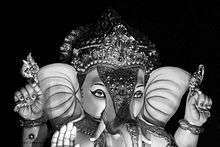
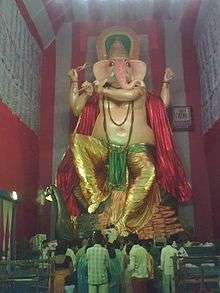
In India, Ganesha Chaturthi is primarily celebrated at home and in public by local community groups in the central and western states of Madhya Pradesh, Maharashtra, Gujarat and Goa and the southern states of Karnataka, Kerala, Andhra Pradesh, Telangana, and Tamil Nadu.
At home
At homes in Maharashtra, families install small clay statues for worship during the festival. The idol is worshiped in the morning and evening with offerings of flowers, durva(strands of young grass), karanji and modaks (jaggery and coconut flakes wrapped in rice flour dumplings).[2][46][47] The worship ends with the singing of an aarti in honour of Ganesha, other gods and saints. In Maharashtra the Marathi aarti "Sukhakarta Dukhaharta", composed by the 17th century saint, Samarth Ramdas is sung.[48] Family traditions differ about when to end the celebration. Domestic celebrations end after 1 1⁄2, 3, 5, 7 or 11 days. At that time the idol is ceremoniously brought to a body of water (such as a lake, river or the sea) for immersion. In Maharashtra, Ganeshotsav also incorporates other festivals, namely Hartalika and the Gauri festival, the former is observed with a fast by women on the day before Ganesh Chaturthi whilst the latter by the installation of idols of Gauris.[49]
In Goa, Ganesh Chaturthi is known as Chavath in Konkani and Parab or Parva ("auspicious celebration");[50] it begins on the third day of the lunar month of Bhadrapada. On this day Parvati and Shiva are worshiped by women, who fast.[51] Instruments such as ghumots, Crash cymbals (ताळ(taal) in Konkani ) and pakhavaj (an Indian barrel-shaped, two-headed drum) are played during the rituals.[52] The harvest festival, Navyachi Pancham, is celebrated the next day; freshly-harvested paddy is brought home from the fields (or temples) and a puja is conducted. Communities who ordinarily eat seafood refrain from doing so during the festival.[51]
In Karnataka the Gowri festival precedes Ganesha Chaturthi, and people across the state wish each other well. In Andhra Pradesh, Ganesha idols of clay (Matti Vinayakudu) and turmeric (Siddhi Vinayakudu) are usually worshiped at home with plaster of Paris idols.
In public

Public celebrations of the festival are popular, and are organised by local youth groups, neighborhood associations or groups of tradespeople. Funds for the public festival are collected from members of the association arranging the celebration, local residents and businesses.[53] The Ganesha idols and accompanying statues are installed in temporary shelters, known as mandaps or pandals. The festival features cultural activities such as singing, theater and orchestral performances and community activities such as free medical checkups, blood-donation sites and donations to the poor. Ganesh Chaturthi, in addition to its religious aspects, is an important economic activity in Mumbai, Surat, Pune, Hyderabad, Bangalore and Chennai. Many artists, industries, and businesses earn a significant amount of their living from the festival, which is a stage for budding artists. Members of other religions also participate in the celebration.[54][55][56]
In Tamil Nadu the festival, also known as Vinayaka Chaturthi or Pillayar Chaturthi, falls on the fourth day after the new moon in the month of Āvaṇi in the Tamil calendar. The idols are usually made of clay or papier-mâché, since plaster of Paris idols have been banned by the state government.. Idols are also made of coconuts and other organic products. They are worshiped for several days in pandals, and immersed in the Bay of Bengal the following Sunday. In Kerala the festival is also known as Lamboodhara Piranalu, which falls in the month of Chingam.[57] In Thiruvananthapuram a procession marches from the Pazhavangadi Ganapathi Temple to Shankumugham Beach, with tall statues of Ganesha made from organic items and milk immersed in the sea.[58]
Abroad
Ganesha Chaturthi is celebrated in the UK by the migrant Hindu population and the large number of Indians living there. The Hindu Culture and Heritage Society, a Southall-based organisation, celebrated Ganesha Chaturthi for the first time in London in 2005 at the Vishwa Hindu Temple; the idol was immersed in the River Thames at Putney Pier. Another celebration, organised by a Gujarati group, has been celebrated in Southend-on-Sea and attracted an estimated 18,000 devotees.[59] Annual celebrations are also held on the River Mersey in Liverpool.[60][61]
The Philadelphia Ganesha Festival is one of the most popular celebrations of Ganesha Chaturthi in North America,[62] and it is also celebrated in Canada, Mauritius, Malaysia and Singapore. The Mauritius festival dates back to 1896,[63] and the Mauritian government has made it a public holiday.[64] In Malaysia and Singapore, the festival is more commonly known as Vinayagar Chaturthi because of the large Tamil-speaking Hindu minority.[65]
Foods

The primary sweet dish during the festival is modak (modak in Marathi and Konkani, modakam or kudumu in Telugu, modaka or kadubu in Kannada, kozhakatta or modakkam in Malayalam and kozhukattai or modagam in Tamil). A modak is a dumpling made from rice or wheat flour, stuffed with grated coconut, jaggery, dried fruits and other condiments and steamed or fried. Another popular sweet dish is the karanji (karjikai in Kannada), similar to modak in composition and taste but in a semicircular shape.This sweet meal is called Nevri in Goa and is synonymous with Ganesh festival amongst the Goans and the Konkani diaspora.[66]
In Andhra Pradesh and Telangana modak, laddu, vundrallu (steamed, coarsely-ground rice-flour balls), panakam (a jaggery-, black pepper- and cardamom-flavored drink), vadapappu (soaked moong lentils) and chalividi (a cooked rice flour and jaggery mixture) are offered to Ganesha. These offerings are known as naivedya, and a plate of modak traditionally holds 21 pieces of the sweet. In Goa, modak and a Goan version of idli (sanna) is popular.[67]
Environmental impact
The Madras High Court ruled in 2004 that immersion of Ganesh idols is unlawful because it incorporates chemicals that pollute the sea water.[68] In Goa the sale of plaster-of Paris Ganesha idols has been banned by the state government and celebrants are encouraged to buy traditional, artisan-made clay idols.[69] Recent initiatives to produce traditional clay Ganesha idols in Hyderabad have been sponsored by the Andhra Pradesh Pollution Control Board.[70][71]
Due to environmental concerns, a number of families now avoid bodies of water and let the clay statue disintegrate in a barrel of water at home. After a few days, the clay is spread in the home garden. In some cities a public, eco-friendly process is used for the immersion.[72]
Gallery
 Ganesh Idol at a pandal in Hyderabad
Ganesh Idol at a pandal in Hyderabad Ganesha procession before immersion in Surat
Ganesha procession before immersion in Surat An Indian Coast Guard helicopter patrols Girgaum Chowpatty during the Ganesha immersion
An Indian Coast Guard helicopter patrols Girgaum Chowpatty during the Ganesha immersion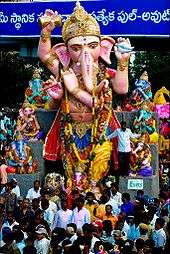 Street festivities in Hyderabad during the festival
Street festivities in Hyderabad during the festival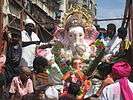 Ganesha procession in Mumbai before immersion
Ganesha procession in Mumbai before immersion Ganesh festival in Hyderabad
Ganesh festival in Hyderabad Immersion of idols at Foreshore Estate in Chennai
Immersion of idols at Foreshore Estate in Chennai- A small clay Ganesha idol in a home during the festival
 Immersion of idol in Sankey Tank, Bangalore
Immersion of idol in Sankey Tank, Bangalore Immersion in Hyderabad using a crane
Immersion in Hyderabad using a crane Ganesha idol immersion procession in Lalbaug, Mumbai
Ganesha idol immersion procession in Lalbaug, Mumbai A Ganesh Idol during immersion in Hyderabad
A Ganesh Idol during immersion in Hyderabad- Immersion procession in the Guruji Talim mandal of Pune
See also
Notes
- ↑ The transformation of Ganesh Chaturthi into a major annual religious and politically significant procession event started in 1894. According to Aslam Syed, the Ganesha statue immersion ritual in the western states of India may have grown because the annual gathering and procession by Shia Muslims on Muharram was allowed by the colonial British government in the 19th and early 20th century, and after the ritual mourning of the death of the 7th century Imam, they would immerse Tazia (Taboots) into river or ocean.[35] The Hindus expanded their own Ganesha processions by walking through the streets, joyfully dancing and reciting their scriptural verses and ended their procession with a ceremonial immersion of Ganesh. The colonial British government attempted to introduce procession license, to Muslims only, which Hindu leaders presented as evidence of discriminatory oppression by the Muslims and the British. The Hindu leaders such as Tilak defied any attempts to selectively stop the Hindu congregational gathering and processions associated with Ganesh Chaturthi.[35][36] The right to organize processions and immersion rituals of Tazia by Muslims, and Ganesha by Hindus, have remained a religious and equal rights issue ever since, particularly when the religious calendars overlap.[37][38]
References
- 1 2 3 4 Ganesh Chaturthi: Hindu Festival, Encyclopædia Britannica (2014)
- 1 2 Darra Goldstein (2015). The Oxford Companion to Sugar and Sweets. Oxford University Press. pp. 82, 254, 458. ISBN 978-0-19-931361-7.
- ↑ K. T. Achaya (2001). A Historical Dictionary of Indian Food. Oxford University Press. pp. 68–69, 132. ISBN 978-0-19-565868-2.
- 1 2 Patrick Taylor; Frederick I. Case (2013). The Encyclopedia of Caribbean Religions. University of Illinois Press. p. 332. ISBN 978-0-252-09433-0.
- 1 2 Lawrence A. Babb (1975). The Divine Hierarchy: Popular Hinduism in Central India. Columbia University Press. pp. 62–63. ISBN 978-0-231-08387-4.
- 1 2 3 Christian Roy (2005). Traditional Festivals: A Multicultural Encyclopedia. ABC-CLIO. pp. 178–180. ISBN 978-1-57607-089-5.
- ↑ Royina Grewal (2009). The Book of Ganesha. Penguin Books. pp. 143–146. ISBN 978-0-14-306760-3.
- 1 2 Paul B. Courtright (1985). Ganesa. Oxford University Press. pp. 230–237. ISBN 978-0-19-503572-8.
- 1 2 Trimbak Vishnu Parvate (1958). Bal Gangadhar Tilak: A Narrative and Interpretative Review of His Life, Career and Contemporary Events. Navajivan. pp. 96–102.
- ↑ Sohoni, Ashutosh (2011). "Ganesh Temple at Tasgaon: Apotheosis of Maratha Temple Architecture". South Asian Studies. Informa UK Limited. 27 (1): 51–73. doi:10.1080/02666030.2011.556011.
- ↑ Ramesh Dutt Ramdoyal (1990). Festivals of Mauritius. Editions de l'Océan Indien. pp. 21–22.
- ↑ "Festivals, Cultural Events and Public Holidays in Mauritius". Mauritius Tourism Authority. Retrieved 28 January 2012.
- ↑ 2017 Ganesh Chaturthi Date and Puja Timings for Santa Cruz de Tenerife, Spain
- ↑ Ganesh Chaturthi in Tenerife
- 1 2 Michael 1983, pp. 99-102.
- 1 2 Rigveda Mandala 2, Hymn 2.23.1, Wikisource, Quote: गणानां त्वा गणपतिं हवामहे कविं कवीनामुपमश्रवस्तमम् । ज्येष्ठराजं ब्रह्मणां ब्रह्मणस्पत आ नः शृण्वन्नूतिभिः सीद सादनम् ॥१॥; For translation, see Grimes (1995), pp. 17-19
- ↑ Sanskrit Original: नि षु सीद गणपते गणेषु त्वामाहुर्विप्रतमं कवीनाम् । न ऋते त्वत्क्रियते किं चनारे महामर्कं मघवञ्चित्रमर्च ॥९॥ – Rigveda 10.112.9; Wikisource
- ↑ Alain Daniélou (1954), The meaning of Ganapati, The Adyar library bulletin X V III. Madras: The Adyar Library, pages 110-111
- ↑ Grimes 1995, pp. 17-19, 201.
- ↑ Michael 1983, pp. 104-108.
- ↑ Michael 1983, pp. 107-108.
- ↑ Michael 1983, pp. 111-112.
- ↑ Michael 1983, pp. 107-109.
- ↑ Michael 1983, pp. 109-110.
- ↑ Michael 1983, pp. 112-113.
- ↑ Paul B Courtright (1985) Gaṇeśa: Lord of Obstacles, Lord of Beginnings, Oxford University Press, ISBN 978-0195057423, pages 7-8, 163-165, 179-183
- 1 2 3 Kapoor, Subodh. The Indian Encyclopaedia. Cosmo Publications. p. 2514. ISBN 978-81-7755-257-7.
- ↑ Richard I. Cashman (1975). The Myth of the Lokamanya Tilak and Mass Politics in Maharashtra. University of California Press. p. 76. ISBN 978-0-520-02407-6.
- ↑ Robin Jeffrey (1990). India: rebellion to republic, selected writings 1857 - 1990. Stirling. pp. 40–41. ISBN 978-8120711075.
- ↑ Kaur, R. (2003). Performative politics and the cultures of Hinduism: Public uses of religion in western India. Anthem Press, page 38- 48.
- ↑ Metcalf, Thomas R.; Metcalf, Barbara Daly. A Concise History of India. ISBN 0-521-63027-4., Metcalf and Metcalf, p. 150.
- ↑ Momin, A. R., The Legacy Of G. S. Ghurye: A Centennial Festschrift, p. 95.
- ↑ Brown, Robert L. (1991). Ganesh: Studies of an Asian God. Albany: State University of New York. p. 9. ISBN 0-7914-0657-1.
- ↑ For Tilak as the first to use large public images in maṇḍapas (pavilions or tents) see: Thapan, p. 225.Thapan, Anita Raina (1997). Understanding Gaņapati: Insights into the Dynamics of a Cult. New Delhi: Manohar Publishers. ISBN 81-7304-195-4.
- 1 2 Aslam Syed (2014). David Jones; Michele Marion, eds. The Dynamics of Cultural Counterpoint in Asian Studies. SUNY Press. pp. 97–98. ISBN 978-1-4384-5191-6.
- ↑ Shabnum Tejani (2008). Indian Secularism: A Social and Intellectual History, 1890-1950. Indiana University Press. pp. 58–61. ISBN 0-253-22044-0.
- ↑ HC's 2-hour immersion breather for home Pujas The Times of India (7 October 2016).
- ↑ Peter van der Veer (2015). Handbook of Religion and the Asian City: Aspiration and Urbanization in the Twenty-First Century. University of California Press. pp. 95–100. ISBN 978-0-520-96108-1.
- ↑ Richard I. Cashman (1975). The Myth of the Lokamanya Tilak and Mass Politics in Maharashtra. University of California Press. p. 75 with footnote 1. ISBN 978-0-520-02407-6.
- ↑ Richard I. Cashman (1975). The Myth of the Lokamanya Tilak and Mass Politics in Maharashtra. University of California Press. pp. 70–73. ISBN 978-0-520-02407-6.
- ↑ Richard I. Cashman (1975). The Myth of the Lokamanya Tilak and Mass Politics in Maharashtra. University of California Press. pp. 75–77. ISBN 978-0-520-02407-6.
- ↑ Cashman, Richard I. (1975). The Myth of the Lokamanya Tilak and Mass Politics in Maharashtra. Berkeley and Los Angeles, California: University of California Press. pp. 75–91. ISBN 0-520-02407-9.
- ↑ "Of fervour & Traditions". http://timesofindia.indiatimes.com/. TOI. Retrieved 23 August 2014. External link in
|website=(help) - ↑ "Andhra laddu-maker eyes to break own Guinness Record with 8000 kg laddu". Daily News and Analysis India. Daily News and Analysis India. 16 September 2015. Retrieved 25 September 2015.
... ready for delivery tomorrow to an 80-feet tall Ganesha idol put up by Visakha Integrated Social Welfare Association supported by NRIs at the Gajuwaka area in Visakhapatnam.
- ↑ "Rituals Explained". thehindutemple.org. Retrieved 21 September 2015.
- ↑ "What is the significance of 'durva' in Ganesh Poojan ?". http://www.sanatan.org/. Retrieved 3 January 2015. External link in
|website=(help) - ↑ Sharma, Usha (2008). Festivals In Indian Society (2 Vols. Set). New Delhi: Mittal publications. p. 144. ISBN 81-8324-113-1.
- ↑ Shanbag, Arun (2007). Prarthana: A Book of Hindu Psalms. Arlington, MA: Arun Shanbag. p. 163. ISBN 978-0-9790081-0-8.
- ↑ Pattanaik, Devdutt (2011). 99 thoughts on Ganesha : [stories, symbols and rituals of India's beloved elephant-headed deity]. Mumbai: Jaico Pub House. p. 61. ISBN 978-81-8495-152-3. Retrieved 29 August 2016.
- ↑ Goa, Daman and Diu (India). Directorate of Archives, Archaeology, and Museum. Purabhilekh-puratatva: Journal of the Directorate of Archives, Archaeology and Museum, Volume 2. Panaji-Goa: The Directorate, 1984. p. 94.
- 1 2 "GANESH CHATURTHI or CHOVOTH". http://www.goatourism.gov.in. Government of Goa. Retrieved 23 August 2014. External link in
|website=(help) - ↑ Singbal, Anwesha. "Bringing the local beat back". http://www.thegoan.net/. The Goan. Archived from the original on 26 August 2014. Retrieved 23 August 2014. External link in
|website=(help) - ↑ Courtright, P. B. (1988). The Ganesh Festival in Maharashtra: Some Observations. The Experience of Hinduism: Essays on Religion in Maharashtra, 84–86.
- ↑ "Kolhapur Muslims mark Ganesha festival with Hindu brothers in mosque". Oneindia. Retrieved 9 September 2015.
- ↑ "Tv9 Gujarat – Hindu-Muslim celebrates Ganesh Chaturthi together, Ahmedabad". TV9 (Gujarati).
- ↑ "Hindu, Muslim families celebrate Ganesh Puja". India Today. Headlines Today. 24 August 2009. Retrieved 9 September 2015.
- ↑ http://www.ganeshchaturthigifts.com/ganesh-chaturthi-pooja.html
- ↑ http://www.ganeshotsavam.org/
- ↑ "Thousands turn out for Hindu Festival at Shoebury East Beach". Southend Standard. 1 September 2009. Retrieved 25 September 2015.
It is thought as many as 18,000 people attended from across Essex, Kent, Middlesex, London, the Midlands and even India.
- ↑ "BBC NEWS – UK – England – Merseyside – River marks religious ceremony". bbc.co.uk.
- ↑ "Liverpool Echo: Latest Liverpool and Merseyside news, sports and what's on". liverpoolecho.
- ↑ Kalyana Ramanathan; Indira Kannan (11 September 2010). "Non-resident gods". Business Standard. Retrieved 14 October 2015.
- ↑ "Mauritius takes the day off for Ganesh Chaturthi". aglobalworld.com. Retrieved 2017-05-29.
- ↑ Patrick Eisenlohr (2006). Little India: Diaspora, Time, and Ethnolinguistic Belonging in Hindu Mauritius. University of California Press. p. 153. ISBN 9780520248793. Retrieved 14 October 2015.
- ↑ "Hindus celebrate Vinayagar Chathurthi". The Malaysian Times. 9 September 2013. Retrieved 14 October 2015.
- ↑ "Ganesh Chaturthi festival fervour grips Goa". http://indianexpress.com/. PTI. Retrieved 27 November 2015. External link in
|website=(help) - ↑ Gazetteer of the Union Territory Goa, Daman and Diu: district gazetteer, Volume 1. Goa, Daman and Diu (India). Gazetteer Dept. 1979. p. 258.
- ↑ "BBC NEWS – South Asia – Ganesha immersions ruled unlawful". bbc.co.uk.
- ↑ Special Correspondent. "Goa bans plaster of Paris Ganesha idols". The Hindu.
- ↑ Editor. "The Environmentally Friendly Ganesh". chakranews.com.
- ↑ "Ganesha immersion: temple's awareness campaign finds many takers". The Hindu.
- ↑ Zha, Bagish K. (20 September 2013). "Eco-friendly 'Ganesh Visarjan' save water and soil from getting polluted in Indore". The Times of India. Retrieved 12 February 2014.
Bibliography
- Grimes, John A. (1995), Ganapati: Song of the Self, SUNY Series in Religious Studies, Albany: State University of New York Press, ISBN 0-7914-2440-5
- Michael, S. M. (1983). "The Origin of the Ganapati Cult". Asian Folklore Studies. 42 (1): 91–116. doi:10.2307/1178368.
External links
| Wikimedia Commons has media related to Ganesh Chaturthi. |

